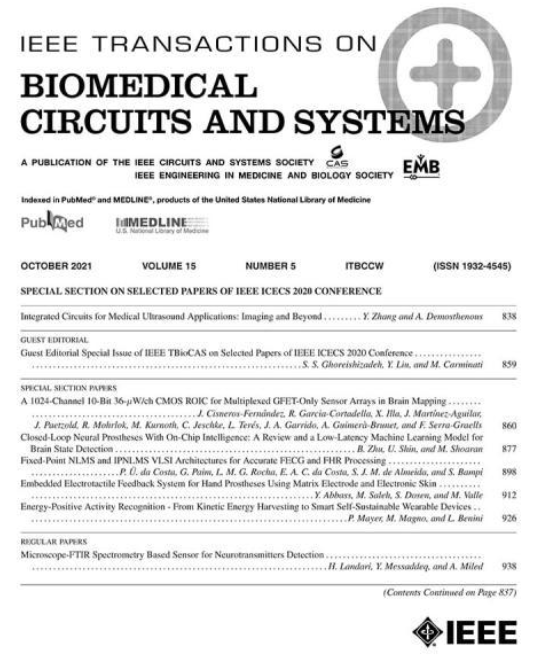Miniaturizing Ultrasonic System for Portable Health Care and Fitness
IF 4.9
2区 医学
Q2 ENGINEERING, BIOMEDICAL
IEEE Transactions on Biomedical Circuits and Systems
Pub Date : 2015-12-01
DOI:10.1109/TBCAS.2015.2508439
引用次数: 37
Abstract
We present a miniaturized portable ultrasonic imager that uses a custom ASIC and a piezoelectric transducer array to transmit and capture 2-D sonographs. The ASIC, fabricated in 0.18 μm 32 V CMOS process, contains 7 identical channels, each with high-voltage level-shifters, high-voltage DC-DC converters, digital TX beamformer, and RX front-end. The chip is powered by a single 1.8 V supply and generates 5 V and 32 V internally using on-chip charge pumps with an efficiency of 33% to provide 32 V pulses for driving a bulk piezoelectric transducer array. The assembled prototype can operate up to 40 MHz, with beamformer delay resolution of 5 ns, and has a measured sensitivity of 225 nV/Pa , minimum detectable signal of 622 Pa assuming 12 dB SNR ( 4σ larger than the noise level), and data acquisition time of 21.3 ms. The system can image human tissue as deep as 5 cm while consuming less than 16.5 μJ per pulse-echo measurement. The high energy efficiency of the imager can enable a number of consumer applications.用于便携式医疗保健和健身的微型化超声系统
我们提出了一种小型便携式超声成像仪,它使用定制的ASIC和压电换能器阵列来传输和捕获二维超声图像。该ASIC采用0.18 μm 32 V CMOS工艺制造,包含7个相同的通道,每个通道都有高压电平移位器、高压DC-DC转换器、数字TX波束变换器和RX前端。该芯片由单个1.8 V电源供电,内部使用片上电荷泵产生5 V和32 V,效率为33%,为驱动大块压电换能器阵列提供32 V脉冲。组装后的样机工作频率可达40 MHz,波束形成器延迟分辨率为5 ns,测量灵敏度为225 nV/Pa,最小可检测信号为622 Pa,假设信噪比为12 dB(比噪声级大4σ),数据采集时间为21.3 ms。该系统可以成像深达5厘米的人体组织,每次脉冲回波测量消耗不到16.5 μJ。该成像仪的高能效可以使许多消费者应用成为可能。
本文章由计算机程序翻译,如有差异,请以英文原文为准。
求助全文
约1分钟内获得全文
求助全文
来源期刊

IEEE Transactions on Biomedical Circuits and Systems
工程技术-工程:电子与电气
CiteScore
10.00
自引率
13.70%
发文量
174
审稿时长
3 months
期刊介绍:
The IEEE Transactions on Biomedical Circuits and Systems addresses areas at the crossroads of Circuits and Systems and Life Sciences. The main emphasis is on microelectronic issues in a wide range of applications found in life sciences, physical sciences and engineering. The primary goal of the journal is to bridge the unique scientific and technical activities of the Circuits and Systems Society to a wide variety of related areas such as: • Bioelectronics • Implantable and wearable electronics like cochlear and retinal prosthesis, motor control, etc. • Biotechnology sensor circuits, integrated systems, and networks • Micropower imaging technology • BioMEMS • Lab-on-chip Bio-nanotechnology • Organic Semiconductors • Biomedical Engineering • Genomics and Proteomics • Neuromorphic Engineering • Smart sensors • Low power micro- and nanoelectronics • Mixed-mode system-on-chip • Wireless technology • Gene circuits and molecular circuits • System biology • Brain science and engineering: such as neuro-informatics, neural prosthesis, cognitive engineering, brain computer interface • Healthcare: information technology for biomedical, epidemiology, and other related life science applications. General, theoretical, and application-oriented papers in the abovementioned technical areas with a Circuits and Systems perspective are encouraged to publish in TBioCAS. Of special interest are biomedical-oriented papers with a Circuits and Systems angle.
 求助内容:
求助内容: 应助结果提醒方式:
应助结果提醒方式:


